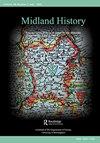Medieval Birmingham. People and places, 1070–1553
IF 0.1
Q3 HISTORY
引用次数: 0
Abstract
extensive survey of post-war architecture that reflects recent redevelopment of the West Midlands. Pointedly, the entire volume is dedicated to the memory of Birmingham Central Library (John Madin Design Group, 1969–74) ‘destroyed’ in 2016. Will the new library (Mecanoo, 2010–13) be similarly demolished when it too falls out of favour? The inclusion of the Shri Venkateswara Balaji Temple in Rowley Regis (Adam Hardy, V. Rao, and Associates, 1997–2006) is a welcome recognition of the region’s diverse religious landscape. The entire volume is considerably enhanced by James O. Davies’s sensitive and versatile photography. Whilst the first editions of the Buildings of England suffered from grainy black and white images, the revised version published by Yale University Press does not. Pictures are a powerful medium for dispelling popular misconceptions of places such as Wolverhampton, Bilston, Solihull, or Walsall enabling Birmingham and the Black Country to celebrate some of England’s least known and underappreciated urban areas. Foster’s epitaph for Wolverhampton – ‘unjustly neglected’ – could be applied to the West Midlands more generally. Thus, this new edition partakes in two traditions. First, Foster treads in the footsteps of many proud local historians, such as N. W. Tildesley and his History of Willenhall (1952). Second, in examining the West Midlands in their own context and terms, Foster builds upon the underestimated role of the Buildings of England in promoting the value of regional architecture. As Foster passionately argues, the Black Country and Birmingham contain as rich a variety of architecture – whether timber-framed, brick, ashlar, steel, or concrete – as anywhere else. It is a real pleasure to read a book that lauds neither north nor south, but the often-forgotten Midlands who have their own abundant history too. Let us hope that city councillors and urban planners, in whose hands the future of this built heritage rests, are listening carefully.中世纪的伯明翰。人和地方,1070–1553
对战后建筑的广泛调查,反映了西米德兰兹郡最近的重建。值得注意的是,整个体量都是为了纪念2016年被“摧毁”的伯明翰中央图书馆(John Madin Design Group, 1969-74)。当新图书馆(Mecanoo, 2010-13)不再受欢迎时,它是否也会被类似地拆除?Rowley Regis的Shri Venkateswara Balaji寺庙(Adam Hardy, V. Rao, and Associates, 1997-2006)是对该地区多样化宗教景观的一个受欢迎的认可。詹姆斯·o·戴维斯的灵敏和多才多艺的摄影大大增强了整个卷。第一版《英格兰建筑》的黑白图像有些粗糙,而耶鲁大学出版社出版的修订版则没有。图片是消除人们对伍尔弗汉普顿、比尔斯顿、索利赫尔或沃尔索尔等地方的普遍误解的有力媒介,使伯明翰和黑乡能够庆祝英格兰一些最不为人知和不被重视的城市地区。福斯特对伍尔弗汉普顿的墓志铭——“被不公正地忽视”——可以更广泛地适用于西米德兰兹郡。因此,这个新版本有两个传统。首先,福斯特踏着许多自豪的当地历史学家的脚步,比如n·w·蒂尔德斯利和他的《威伦霍尔历史》(1952)。其次,在考察西米德兰兹郡自身的背景和条件时,福斯特建立在英格兰建筑在促进地区建筑价值方面被低估的作用之上。正如福斯特充满激情地指出的那样,黑人国家和伯明翰拥有丰富多样的建筑——无论是木结构的、砖的、石的、钢的还是混凝土的——和其他任何地方一样。读一本既不赞美北方也不赞美南方的书是一种真正的乐趣,它赞美的是经常被遗忘的中部地区,那里也有自己丰富的历史。让我们希望,这些建筑遗产的未来掌握在市议员和城市规划者的手中,他们正在认真倾听。
本文章由计算机程序翻译,如有差异,请以英文原文为准。
求助全文
约1分钟内获得全文
求助全文

 求助内容:
求助内容: 应助结果提醒方式:
应助结果提醒方式:


